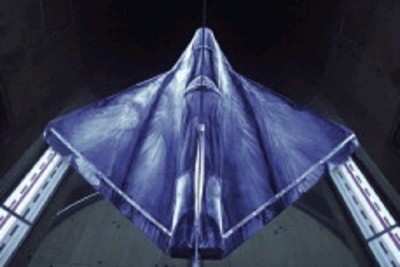Wed, Sep 09, 2009
Future Engineers Prepare To Test Future UAS
 Engineering apprentices at BAE
Systems are adding the final touches to an experimental aircraft
that will test radical new methods of controlling it in flight.
Engineering apprentices at BAE
Systems are adding the final touches to an experimental aircraft
that will test radical new methods of controlling it in flight.
The demonstrator has been built under a project to explore
technologies destined for use on future unmanned aircraft systems
(UAS). Known as Demon, the aircraft is the outcome of a project
called FLAVIIR (Flapless Air Vehicle Integrated Industrial
Research). This five-year program costing nearly $11 million is
jointly funded by BAE Systems and the Engineering and Physical
Sciences Research Council (EPSRC).
FLAVIIR brings together 10 universities, led by Cranfield
University and BAE Systems. Its major focus is to develop the
technologies needed to build a low-cost, low maintenance UAS with
no conventional control surfaces, such as wing flaps and without
losing any performance compared to conventional aircraft.
Matt Pearson, Demon Delivery Manager, said the aircraft is a 176
pound, jet-powered UAS with a wing span of about 8 feet. It was
designed at Cranfield University, with the support of the other
partner institutions, and manufacture and assembly has been carried
out jointly by Cranfield's Composite Manufacturing Center and BAE
Systems apprentices.

BAE Demon Photo Courtesy BAE
Systems
Matt described the apprentices working on Demon as the
"engineers of the future, working on the technology of the future".
He said they had taken the air frame, fitted it out, and added all
the wiring and electrical systems needed to create a working,
functioning aircraft. Now in the final stages of assembly, Demon
will make its first test flights later this year. The project has
developed a number of ways of doing away with flaps and the flight
tests will evaluate which of these is best.
Richard Williams, Program Director Future Capability, is
delighted with the Demon's progress: "Projects such as Demon have
several advantages for BAE Systems. "They help to ensure we get the
greatest benefit from our invested research money and offer
continued benefit from the increase in the capability and
competencies of the universities involved."
More News
Have A Story That NEEDS To Be Featured On Aero-News? Here’s How To Submit A Story To Our Team Some of the greatest new stories ANN has ever covered have been submitted by our>[...]
“The legislation now includes a task force with industry representation ensuring that we have a seat at the table and our voice will be heard as conversations about the futur>[...]
Aero Linx: Waco Museum The WACO Historical Society, in addition to preserving aviation's past, is also dedicated and actively works to nurture aviation's future through its Learnin>[...]
Adcock Range National low-frequency radio navigation system (c.1930-c.1950) replaced by an omnirange (VOR) system. It consisted of four segmented quadrants broadcasting Morse Code >[...]
Also: uAvionix AV-Link, Does Simming Make Better Pilots?, World Games, AMA National Fun Fly Czech sportplane manufacturer Direct Fly has finished delivering its 200th ALTO NG, the >[...]
 ANN FAQ: Submit a News Story!
ANN FAQ: Submit a News Story! Aero-News: Quote of the Day (06.12.24)
Aero-News: Quote of the Day (06.12.24) ANN's Daily Aero-Linx (06.12.24)
ANN's Daily Aero-Linx (06.12.24) ANN's Daily Aero-Term (06.12.24): Adcock Range
ANN's Daily Aero-Term (06.12.24): Adcock Range Airborne Affordable Flyers 06.06.24: 200th ALTO, Rotax SB, Risen 916iSV
Airborne Affordable Flyers 06.06.24: 200th ALTO, Rotax SB, Risen 916iSV



